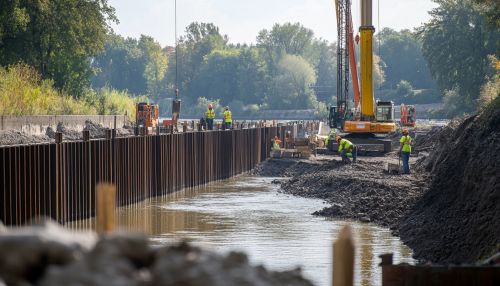Sheet Piles
Introduction
Sheet piles are structural elements used in construction to retain soil, water, or other materials. These interlocking sections are driven into the ground to form a continuous barrier, providing support and stability in various civil engineering projects. Sheet piles are commonly employed in the construction of retaining walls, cofferdams, seawalls, and underground structures. Their versatility and ease of installation make them a preferred choice in both temporary and permanent applications.
Types of Sheet Piles
Sheet piles are manufactured from different materials, each offering unique properties and advantages. The primary types of sheet piles include:
Steel Sheet Piles
Steel sheet piles are the most commonly used type due to their high strength, durability, and ease of installation. They are typically made from hot-rolled steel and are available in various shapes, such as U-shaped, Z-shaped, and straight web sections. Steel sheet piles are suitable for a wide range of applications, including deep excavations and marine environments.
Vinyl and Composite Sheet Piles
Vinyl and composite sheet piles are made from polyvinyl chloride (PVC) or a combination of materials like fiberglass and resin. These sheet piles are lightweight, corrosion-resistant, and environmentally friendly. They are often used in applications where exposure to harsh chemicals or saltwater is a concern, such as in coastal protection projects.
Concrete Sheet Piles
Concrete sheet piles are precast or cast-in-situ elements used in situations where high durability and resistance to environmental factors are required. They are often reinforced with steel to enhance their structural performance. Concrete sheet piles are commonly used in permanent structures, such as quay walls and bridge abutments.
Timber Sheet Piles
Timber sheet piles are made from treated wood and are primarily used in temporary applications or in areas with low environmental stress. While not as durable as other materials, timber sheet piles are cost-effective and easy to handle.
Design Considerations
The design of sheet pile structures involves several critical considerations to ensure stability and performance. Key factors include:
Soil Conditions
Understanding the soil properties is essential for selecting the appropriate type and length of sheet piles. Soil conditions influence the driving method, the depth of penetration, and the overall stability of the structure.
Load Requirements
Sheet piles must be designed to withstand various loads, including earth pressure, water pressure, and any additional loads from structures or vehicles. Engineers must calculate these loads to ensure the sheet pile wall can maintain its integrity under all conditions.
Corrosion Protection
Corrosion is a significant concern, especially for steel sheet piles used in marine or chemically aggressive environments. Protective coatings, cathodic protection, and the use of corrosion-resistant materials are common strategies to extend the lifespan of sheet piles.
Environmental Impact
The environmental impact of sheet pile installation must be considered, particularly in sensitive ecosystems. Measures such as noise reduction during driving and the use of environmentally friendly materials can mitigate adverse effects.
Installation Methods
The installation of sheet piles involves several techniques, each suited to specific site conditions and project requirements. Common methods include:
Driving
Driving is the most traditional method of installing sheet piles, using impact hammers, vibratory hammers, or hydraulic presses. The choice of equipment depends on factors such as soil type, pile material, and environmental constraints.
Jetting
Jetting involves using high-pressure water jets to assist in the penetration of sheet piles into the ground. This method is particularly useful in sandy or loose soils where driving alone may be insufficient.
Pre-augering
Pre-augering involves drilling a hole in the ground before installing the sheet pile. This technique is used in dense or hard soils to reduce resistance and facilitate easier installation.
Pressing
Pressing is a silent and vibration-free method of installing sheet piles, ideal for urban areas or sites with strict noise and vibration restrictions. Hydraulic jacks are used to push the piles into the ground without impacting the surrounding environment.


Applications
Sheet piles are utilized in a variety of construction projects, each with specific requirements and challenges:
Retaining Walls
Sheet piles are commonly used to construct retaining walls, which support excavations and prevent soil erosion. These structures are essential in urban development, where space constraints require vertical excavation.
Cofferdams
Cofferdams are temporary enclosures built to allow construction work in waterlogged areas. Sheet piles form the perimeter of the cofferdam, providing a dry work environment by preventing water ingress.
Seawalls and Bulkheads
In coastal engineering, sheet piles are used to construct seawalls and bulkheads, protecting shorelines from erosion and storm surges. These structures are crucial in safeguarding infrastructure and property in coastal regions.
Underground Structures
Sheet piles are employed in the construction of underground structures such as tunnels, basements, and underground parking facilities. They provide lateral support during excavation and help maintain the integrity of the surrounding soil.
Advantages and Limitations
Sheet piles offer several advantages, making them a popular choice in construction:
Advantages
- **Versatility:** Sheet piles can be used in a wide range of applications, from temporary structures to permanent installations.
- **Ease of Installation:** The installation process is relatively quick and straightforward, reducing construction time and costs.
- **Reusability:** Steel and vinyl sheet piles can be extracted and reused in different projects, enhancing their cost-effectiveness.
- **Environmental Benefits:** Vinyl and composite sheet piles are environmentally friendly, offering a sustainable alternative to traditional materials.
Limitations
- **Corrosion:** Steel sheet piles are susceptible to corrosion, particularly in marine environments, necessitating protective measures.
- **Noise and Vibration:** The driving process can generate significant noise and vibration, which may be disruptive in urban areas.
- **Limited Aesthetic Appeal:** The industrial appearance of sheet piles may not be suitable for projects requiring high aesthetic standards.
